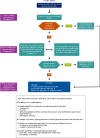Development of a low back pain care pathway in an academic hospital system: results of a consensus process
- PMID: 38169412
- PMCID: PMC10763186
- DOI: 10.1186/s13018-023-04492-z
Development of a low back pain care pathway in an academic hospital system: results of a consensus process
Abstract
Background: Low back pain (LBP) is the leading cause of disability worldwide and a significant component of healthcare expenditures. Clinical practice guidelines (CPGs) have been highlighted as a key resource to improve the quality of care. This study aimed to develop a clinical pathway for LBP based on CPGs in an academic health system.
Methods: We conducted a modified Delphi study of clinicians caring for patients with LBP who were asked to rate 21 CPG-informed seed statements through an online survey. The goal was to identify statements that achieved a minimum of 80% consensus among panelists.
Results: Thirty-five healthcare providers participated as panelists. The majority of participants were male (68.6%), had MD or DO (62.9%) degrees, and were clinicians (73.8%) working in neurosurgery (36.1%), orthopedics (25.7%), emergency medicine (14.3%), or physical therapy (11.4%). Initially, consensus was reached on 20 of 21 seed statements. One statement did not reach consensus in the initial round and was revised into two separate statements based on feedback from panelists. One of these statements achieved consensus in the second review round. All statements reaching consensus were incorporated into a care pathway consisting of diagnosis, evaluation, and treatment for LBP.
Conclusion: Healthcare providers across various disciplines supported statements interpreting current CPGs related to care for LBP. This study represents a step toward supporting guideline-concordant care for LBP. Additional research is needed to assess how such pathways impact actual clinical care.
Keywords: Care pathway; Chiropractic; Clinical practice guideline; Delphi; Low back pain; Physical therapy; Spinal pain.
© 2023. The Author(s).
Conflict of interest statement
The authors declare no competing interests.
References
-
- GBD 2016 DALYs and HALE Collaborators Global, regional, and national disability-adjusted life-years (DALYs) for 333 diseases and injuries and healthy life expectancy (HALE) for 195 countries and territories, 1990–2016: a systematic analysis for the Global Burden of Disease Study 2016. Lancet Lond Engl. 2017;390(10100):1260–1344. doi: 10.1016/S0140-6736(17)32130-X. - DOI - PMC - PubMed
MeSH terms
LinkOut - more resources
Full Text Sources
Miscellaneous


